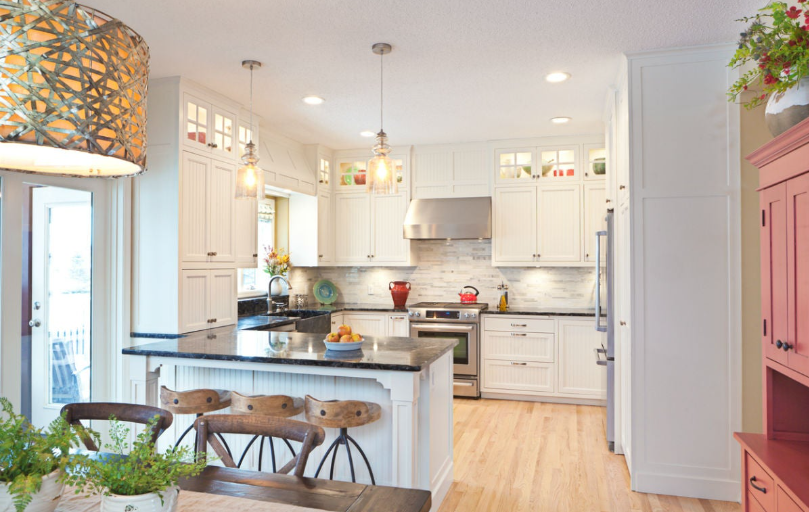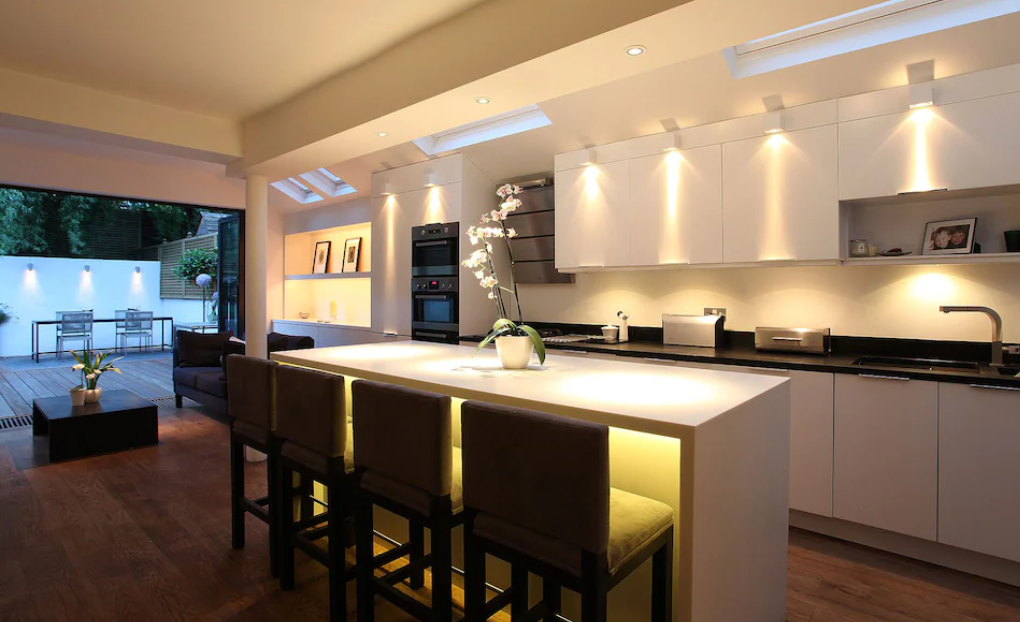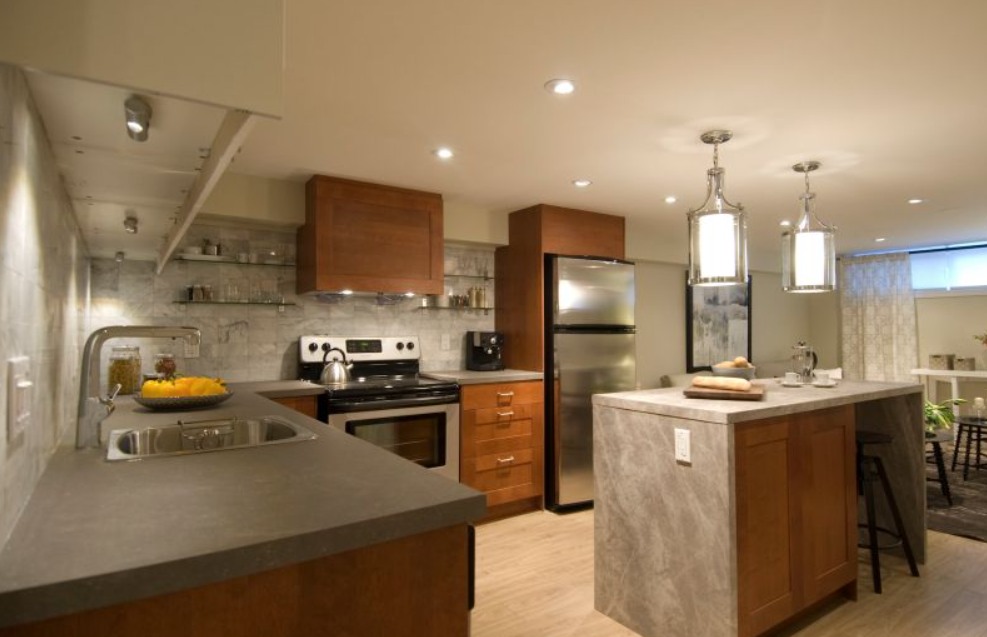Lighting in the kitchen is important for many reasons. It can help to create a bright and inviting space, set the mood for cooking and entertaining, and even help to make food preparation more efficient. One popular type of lighting for the kitchen is spotlights.
Why do you use spotlights in kitchen?

Spotlights can be a great way to add both function and style to your kitchen. But before you start shopping for fixtures, it’s important to think about how you want to position them in the space.
The light that spotlights may produce is intense and can be directed to a specific area. This is why they are often used to highlight certain features in a room, such as artwork or architectural details. When it comes to the kitchen, spotlights can be used to illuminate countertops, backsplashes, and even appliances.
When thinking of the lighting system in your kitchen, you should consider several moments. First, individuals must understand the practical application of light in the kitchen. Second, you should also take into account the different areas in your kitchen that will need to be lit. For example, task lighting is important for food preparation and cooking, while accent lighting can highlight certain features or create a more inviting atmosphere. Third, you’ll need to decide on the type of fixtures you want to use. There are many different options available, from recessed lights to pendant lights to track lighting. Once you’ve determined what type of light you need and where you want to position it, you can start shopping for fixtures.
The type of lighting in the kitchen should be bright and evenly diffused. The most common type of kitchen lighting is fluorescent tube lights. These produce a bright, white light that is perfect for preparing food and cooking. However, they can also be harsh and not very inviting. If you want to create a more welcoming atmosphere in your kitchen, you might consider using incandescent bulbs instead. These give off a softer, yellow light that can make the space feel cozier.
How to position spotlights in kitchen?
In order to space out spotlights in your kitchen, you will first need to take into account the size of your kitchen and the amount of light that you need. Once you have a general idea of where you want to position your spotlights, you can start spacing them out evenly throughout the room. It’s important to leave enough space between each fixture so that the light is diffused and doesn’t create any hotspots. You should also make sure that the fixtures are pointing in different directions so that the light is evenly distributed.
The best position for LED spotlights is determined by a number of factors, such as the room's size, the ceiling's height, and how it is utilized. Spotlights should be evenly placed at distances of 1 meter from each other and from the ceiling's edges in general. This is to ensure that the light is evenly distributed in the room and that there are no hotspots.
The type of lighting in the kitchen should be bright and evenly diffused. The most common type of kitchen lighting is fluorescent tube lights. These produce a bright, white light that is perfect for preparing food and cooking. However, they can also be harsh and not very inviting. If you want to create a more welcoming atmosphere in your kitchen, you might consider using incandescent bulbs instead. These give off a softer, yellow light that can make the space feel cozier.
How far should spotlights be from kitchen cabinets?
Professional installation technicians often get confused about the ideal lighting distance from cabinets. To avoid shadowing, the lights should be placed 45.76 centimetres (18 inches) from the top of the cabinet.

Such a distance allows the light to hit the wall above the cabinets and bounce back, filling in any dark spots. This method is called "washing" the wall with light and creates a more evenly lit space. It's best to use multiple spotlights rather than a single, central fixture when lighting kitchen cabinets. This will help to avoid any hot spots or shadows on the face of the cabinets.
How many spotlights should I have in my kitchen?
The square footage of your space plays a significant part in this decision. A good rule of thumb is one spotlight for every 50 square feet. But keep in mind that the height of your ceilings will also affect how much light is necessary. If you have higher ceilings, you might need to use more spotlights to adequately illuminate the space. So in case your room is 30 feet long and 10 feet wide, the calculation is 30 x 10 = 300.
The amount of foot-candles you'll need varies depending on the function of your room. A kitchen, for example, will require more foot-candles than a bedroom since it is a work environment. This parameter usually ranges from 30 to 60. For example, a 50-square-foot kitchen with 8-foot ceilings will require at least four spotlights. But if the ceilings are higher, you might need to add an additional light or two to achieve the desired amount of foot-candles.
Finally, you have to multiply the foot-candles required for the kitchen and its footage. Thus, on assumption that you have a kitchen of 300 square feet and need 30 foot-candles, you will need 9,000 lumens.
Can you have too much lighting in a kitchen?
The kitchen is not exempt. And, while this may seem perplexing, a kitchen can have too much light but not enough. A great deal of illumination is required because we use the space to perform various tasks.
For instance, when we are cooking, we need a light that will allow us to see what we are doing. If the light is not adequate, we could end up cutting ourselves or making a mess of the food. On the other hand, if there is too much light, it can cause glare and make it difficult to see what we are doing. The best way to achieve the perfect balance is to use a combination of task lighting and ambient lighting.
Task lighting is used to provide direct illumination on a specific area. This might include under-cabinet lighting or pendant lights over an island. Ambient lighting, on the other hand, is used to create a general level of illumination in the room. This can be accomplished with recessed lights, track lights, or even wall sconces.
When it comes to kitchen lighting, more is not always better. The key is to find the right balance of task lighting and ambient lighting to create a space that is both functional and inviting.

What color temperature is the best for kitchen?
It may sound strange, but not only the position of spotlights in kitchen may affect the atmosphere in it. The light color also matters. The light color is measured on the Kelvin (K) scale.
The rule of thumb is that a lower Kelvin number means the light will appear more yellow, while a higher Kelvin number will appear more blue. So, for example, a 2700K light bulb will give off a warm, yellowish light, while a 4100K light bulb will give off a cooler, bluer light.
The type of lighting you use in your kitchen can have a big impact on the overall feel of the space. If you want to create a warm and inviting atmosphere, you might consider using incandescent bulbs with a lower Kelvin rating. These give off a softer, yellow light that can make the space feel cozy. On the other hand, if you want a brighter, more functional space, you might opt for fluorescent tube lights with a higher Kelvin rating. These produce a bright, white light that is perfect for preparing food and cooking.
In conclusion, the best position for LED spotlights in the kitchen is determined by the room's size, the ceiling's height, and how it is utilized. Spotlights should be evenly placed at distances of 1 meter from each other and from the ceiling's edges in general. This is to ensure that the light is evenly distributed in the room and that there are no hotspots.
How to install spotlights?
When attaching them to the ceiling, there are a lot of problems that may occur, like making the holes too big or not lining them up correctly. To make sure this does not happen, it is recommended to use a template. Most hardware stores will have these available for purchase.
Another thing to keep in mind is the type of ceiling you have. If it is a suspended ceiling, then you will need to use hangers that are specifically made for that type of installation. Otherwise, you run the risk of the spotlight falling and breaking.
For a more permanent installation, you can screw the spotlight into the ceiling. This will provide a stronger hold and will prevent the light from moving around. However, it is important to make sure that you do not over-tighten the screws as this could strip the threads or damage the light fixture.
Once you have the spotlight installed, you will need to connect it to a power source. If you are using an electrical box, then you will need to connect the wires to the correct terminals. Make sure that the wires are tight and secure before turning on the power. If you are hardwiring the light directly to the wall, then you will need to use wire nuts to make the connection. Again, make sure that the connection is tight and secure before turning on the electricity.
Now that you know how to position spotlights in kitchen and how to install them, you can create a space that is both functional and inviting.
What are the alternatives?

Sometimes when you have already installed the spotlights on the ceiling, you may have hesitations about their position. In this case, you can always try alternative solutions like track lighting or even wall sconces. These might create a more pleasant atmosphere in your kitchen and still provide adequate illumination for cooking and other tasks.
You can replace spotlights with other types of lighting fixtures depending on your needs and preferences. Just make sure that the light is evenly distributed in the room and that there are no hotspots. With a little bit of trial and error, you are sure to find the perfect lighting solution for your kitchen.
Also, you can try to use different color temperatures to create different atmospheres in your kitchen. A lower Kelvin rating will give off a warm, yellowish light, while a higher Kelvin rating will produce a bright, white light. experiment with different lighting solutions to find the perfect one for your needs.
Conclusion
When you already know how to position spotlights in the kitchen and how to install them, you can create a space that is both functional and inviting. You can also try alternative solutions like track lighting or even wall sconces. Just make sure that the light is evenly distributed in the room and that there are no hotspots. With a little bit of trial and error, you are sure to find the perfect lighting solution for your kitchen.